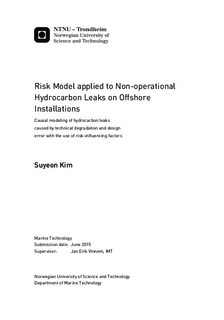| dc.description.abstract | This project proposes a risk model for identifying causal factors of hydrocarbon (HC) leaks on offshore installations and estimating the platform-specific frequency of HC leaks. The central concern is non-operational leaks caused by either technical degradation or design error.
The model development is based on the investigation of previous HC leaks incidents using incident investigation reports. The investigation covers 25 leaks which occurred in the UK, Norway, and the USA, and the relevant literature is also referred to for some types of leaks due to the small number of investigation reports. The techniques used for the modeling process are Bayesian Belief Network (BBN) and Event Tree Analysis (ETA).
The developed model provides the Risk-Influencing Factors (RIFs) for HC leaks caused by technical degradation and design error. The identified RIFs for leaks caused by technical degradation are divided into two types: the common RIFs applied to all types of technical degradation leaks and the specific RIFs applied to a certain type of technical degradation leaks. In case of leaks caused by design error, the RIFs are identified in the equipment and system levels. Since the identified RIFs are highly relevant to the specific condition of installations, it is verified that the platform-specific frequency needs to be applied to non-operational leaks, which has not been considered in conventional Quantitative Risk Assessment (QRA) studies.
With regard to the usage of this model, it is possible to assess the condition of an installation associated with the likelihood of HC leaks occurrence by evaluating the status of the identified RIFs on the installation in the same way as performed in previous work such as BORA-Release and the Risk OMT model. Then, generic leak frequencies are changed into installation-specific leak frequencies according to the assessed condition.
If further studies focus on the quantitative use of the developed model and the verification of the identified RIFs, the platform-specific frequency for all types of HC leaks can be estimated using this model combined with the Risk OMT model which covered operational leaks. | |

